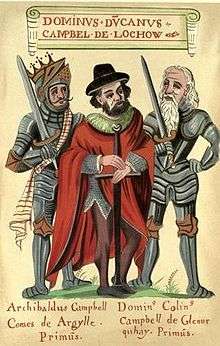Duncan Campbell, 1st Lord Campbell
Duncan Campbell, 1st Lord Campbell (Classical Gaelic Donnchadh mac Cailein, and also called Donnchadh na-Adh (English: Duncan the fortunate) of Loch Awe, (died 1453), was a Scottish nobleman and politician. He was an important figure in Scottish affairs in the first half of the 15th century and Justiciar of Argyll. He was head of the Clan Campbell for 40 years.

Family
Duncan's date of birth is in 1390 in Lochow, Argyll.[1] He was the son of Colin Campbell of Lochawe[2], and Mariota Campbell. Colin (called Colin Iongantach 'Wonderful', and 'Colin The Good Knight') was the eldest son of Archibald Campbell of Lochawe, while Mariota was the daughter of John Campbell, and thus heiress to the lands of Ardscotnish and Glen Orchy. Colin obtained a dispensation by 13 January 1366 permitting the marriage of Mariota to his son John. He evidently changed his plans and married Mariota himself as in 1372 he obtained a second dispensation, this allowing Colin and Mariota to remarry, after a separation, having already married although within the prohibited degree of kinship.[3]
Duncan may not have been their eldest son: a brother named John Annam, John the Weak, is said to have been passed over. Duncan was seemingly the chosen heir by 6 February 1393 when he was granted the lands of Menstrie by his father. On Colin's death, some time before 19 January 1414, Duncan became head of the Campbells of Loch Awe.[4]
Family ties
Duncan was twice married, first to Marjorie (d. before August 1432), daughter of Robert Stewart, Duke of Albany, secondly to Margaret Stewart of Ardgowan (d. after August 1442).
Duncan's closeness to the Albany Stewarts led to King James I of Scotland viewing him with some suspicion, and James sent Duncan south as a hostage in England. The documentary record calls him Campbell of Argyll, and gives his share of the liability for the king's ransom as 1500 merks, more than any other hostage save one.[5] In time Duncan and the king were somewhat reconciled and following James's assassination Duncan was among the supporters of Queen Dowager Joan.
"The fortunate"
During the minority of King James II, Duncan professed support and loyalty to the regency, while constantly expanding his power in Argyll, often at the expense of the Crown. He was nevertheless knighted before March 1440 and created a Lord of Parliament as Lord Campbell of Lochawe by James II in 1445.
Death
He died between February 1453 and 21 May 1454, and was buried in the collegiate church at Kilmun, which he and his wife Margaret Stewart had founded in 1442 (see Kilmun Church). Their effigies can still be seen in a niche with a wide cusped arch.[6]
His first successor was Archibald, Master of Campbell; also known as Archibald Roy of Kilbride since he was born in Kilbride, two miles from Inverary. Archibald Roy of Kilbride was the 14th Campbell, the Sixth McCailen More, and 16th Knight of Lochow.[7]
His second son by his wife Margaret, Colin, was the founder of the Campbell of Breadalbane line (Earl of Breadalbane and Holland). His other sons by his second marriage, Archibald, Duncan, and Neil, created the Campbell septs of Otter, Auchinbreck, and Ormidale, respectively.[8]
His grandson Colin, son of Archibald 'Gillespic,' (d. 1440) his only child by his first wife, succeeded him as Chief of the Clan Campbell.[9]
Notes
- "Ancestral File". FamilySearch. Retrieved 7 February 2014.
- Balfour Paul, Sir James, The Scots' Peerage, Edinburgh, 1904, vol.1, p.328-330.
- Boardman, The Campbells, pp. 72–72, 102 & 104; Paul, The Scots Peerage, Vol I, p. 330.
- Boardman, The Campbells, pp. 104 & 109–110.
- Boardman, The Campbells, p. 291. William Douglas, heir of the Lord of Dalkeith, was also assessed as liable for 1500 merks. See also Paul, The Scots Peerage, vol. I, p. 330, where the amount is described as Duncan's income. The value of 1500 Scots merks in English Pounds sterling, in then-current gold coin was some 750 English merks or 500 pounds sterling. The Scots demy (108 pence Scots money) was considered to be of equal value to the English half-noble (54 pence English money); Grueber, Handbook, p. 171.
- "Kilmun, St Munn's Parish Church (Church of Scotland) Including Argyll and Douglas Mausolea, Associated Buildings and Graveyard". Historic Environment Scotland. Retrieved 22 August 2016.
- The House of Argyll and the Collateral Branches of the Clan Campbell. p. 32.
- Paul, James Balfour (1904). The Scots Peerage. Edinburgh: Douglas. p. 1:331-32. Retrieved 22 August 2016.
- Paul. The Scots Peerage. p. 1:332.
References
- Boardman, Stephen (2000), "The Tale of Leper John and the Campbell Acquisition of Lorn", in Cowan, E.J.; McDonald, R. Andrew (eds.), Alba: Celtic Scotland in the Medieval Era, East Linton: Tuckwell, ISBN 1-86232-151-5
- Boardman, Stephen (2006), The Campbells, 1250–1513, Edinburgh: John Donald, ISBN 0-85976-662-4
- Grueber, Herbert Appold (1899), Handbook of the Coins of Great Britain and Ireland in the British Museum, London: The British Museum
- Paul, Sir James Balfour (1904), The Scots Peerage, 1, Edinburgh: David Douglas